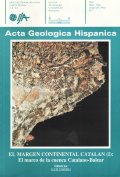Determinación del flujo de calor a partir de sondeos petroleros en la Cuenca Catalano-Balear
Abstract
A method using information from oil wells has been applied to calculate heat flow at seven oil wells in the Valencia trough, a Neogene extensional basin located in the western Mediterranean. Most of these weils penetrate the Cenozoic sedimentary cover and the underlying Mesozoic sequences and the Paleozoic basement. The basic data set consists of well logs, rock samples including cuttings and cores, and bottom hole (BHT) and dril1 stem test (DST) temperature data. Thermal conductivity of the rock matrix is determined from the conductivities and volumetric fractions of its mineral components by using a geometrical mean model. The in-situ thermal conductivity profile is then obtained as a function of porosity, and it is corrected for in-situ temperature conditions. The sonic log has been used to estimate the porosity profile, which has been corrected depending on the clay content of the formation. Finally, vertical heat flow variation is calculated at every well by combining bulk thermal conductivity profile and geothermal gradients.
The bulk thermal conductivity has been shown to be very sensitive to lithologic and porosity changes, with values that vary from 1.5 W m-K-' for shales with over 40 percent porosity, to about 4.3 W m-' K-' for dolomites and consolidated quartz-rich sandstones that constitute the basement. The maximum thermal conductivity values are attained for the basement materials and are due to the low porosity (caused by compaction and burial) and to the high matrix conductivities of Mesozoic carbonates and sandstones. The mean bulk thermal conductivity of the sediments is found to be about 2 W m-' K-l. Therefore, a thermal blanketing effect is likely to occur due to the conductivity contrast between the sedimentary cover and the underlying basement. This effect, which has been neglected in previous models of the thermal evolution of the Valencia trough, probably has acted to slow down post-extensional lithospheric cooling and to reduce tectonic subsidence.
A regional thermal gradient of 3612 "C km-' is obtained from the available temperature data. This value is siightly lower than that estimated from a set of wells in the southwestern part of the basin. The calculated heat flow values are highly scattered, the maximum value being located in the southwestern part of the basin. As a consequence, the resulting heat flow agrees with the increase towards the SW previously observed in the Valencia trough. The mean heat flow value in the study area is determined to be 85-90 mW m-2. Although thermal conductivity could be overestimated, this value is too high to be just a consequence of the rifting process in the Valencia trough, since most of the wells considered are located in the northernmost part of the basin. The thermal effect of groundwater circulation is proposed to be in part responsible for the positive and negative thermal gradient anomalies.
Fracturing and karstification, which has been widely recognized in the Mesozoic carbonates in the basement, together with the temperature data and porosity results, support this hypothesis.


